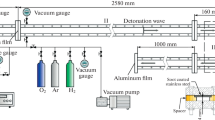Abstract
In this study, the onset of detonation downstream of a perforated plate subsequent to the reflection of a Chapman–Jouguet detonation upstream is investigated. The experiments were performed with C3H8 + 5O2 and C2H2+2.5O2+70%Ar. The former has a much more irregular transverse wave pattern whereas the latter is known to have a piecewise laminar structure with a regular cellular structure. The onset of detonation phenomenon was found to be significantly different for the two mixtures. For the high argon diluted mixtures, the onset of detonation occurs in the vicinity downstream of the perforated plate. However, if the onset of detonation does not occur close to the plate, the precursor shock decouples from the reaction zone and a deflagration results. For the propane–oxygen mixtures, the onset of detonation is found to occur relatively far from the perforated plate at critical conditions. The major difference between these two mixtures is that the metastable turbulent reaction front can be maintained for relatively long distances for the propane–oxygen mixture. This turbulent metastable regime is also observed to be able to maintain a relatively constant propagation velocity for many channel widths prior to the onset of detonation. For the propane–oxygen mixtures, the onset is caused by a strong local explosion within the turbulent reaction zone.
Similar content being viewed by others
References
Urtiew P., Oppenheim A.K.: Experimental observation of the transition to detonation in an explosive gas. Proc. R. Soc. Lond. Ser. A 295, 13–28 (1966)
Shepherd J.E.: Detonation in gases. Proc. Combust. Inst. 32, 83–98 (2009)
Shepherd J.E., Moen I.O., Murray S.B., Thibault P.A.: Analyses of the cellular structure of detonations. Proc. Combust. Inst. 21, 1649–1658 (1986)
Lee J.H.S., Radulescu M.I.: On the hydrodynamic thickness of cellular detonations. Combust. Explo. Shock Waves 41(6), 745–765 (2005)
Radulescu M.I., Sharpe G.J., Law C.K., Lee J.H.S.: The hydrodynamic structure of unstable cellular detonations. J. Fluid Mech. 580, 31–81 (2007)
Radulescu M.I., Ng H.D., Varatharajan B., Lee J.H.S.: The effect of argon dilution on the stability of acetylene–oxygen detonations. Proc. Combust. Inst. 29, 2825–2831 (2002)
Ng H.D., Radulescu M.I., Higgins A.J., Nikiforakis N., Lee J.H.S.: Numerical investigation of the instability for one-dimensional Chapman-Jouguet detonations with chain-branching kinetics. Combust. Theory Model. 9, 385–401 (2005)
Chao J., Otsuka T., Lee J.H.S.: An experimental investigation of the onset of detonation. Proc. Combust. Inst. 30, 1889–1897 (2005)
Zhu Y.J., Chao J., Lee J.H.S.: An experimental investigation of the propagation mechanism of critical deflagration waves that lead to the onset of detonation. Proc. Combust. Inst. 31(2), 2455–2462 (2007)
Author information
Authors and Affiliations
Corresponding author
Additional information
Communicated by F. Zhang.
Rights and permissions
About this article
Cite this article
Grondin, JS., Lee, J.H.S. Experimental observation of the onset of detonation downstream of a perforated plate. Shock Waves 20, 381–386 (2010). https://doi.org/10.1007/s00193-010-0267-x
Received:
Revised:
Accepted:
Published:
Issue Date:
DOI: https://doi.org/10.1007/s00193-010-0267-x




